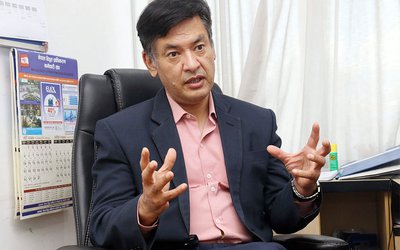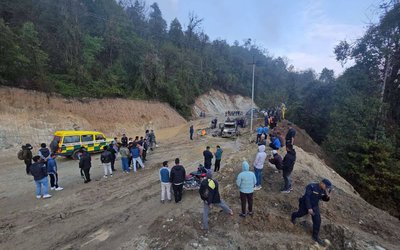
What is the Rahughat Hydropower Project?
Rahughat is a 40 MW Peaking Hydropower Project. Export-Import (EXIM) Bank of India is providing a concessional loan investment of $67 million and Nepal Electricity Authority (NEA) is bearing the remaining cost. The project is divided into two lots. Indian construction company Jaiprasad (JP) Associates is responsible for civil works and Bharat Heavy Electrical Limited (BHEL), which is engaged by Jaiprasad on EPC model, will work on electro-mechanical side like installation, supply and transportation of civil and hydro mechanical equipment and switchgear. If we work on this model, the price will be adjusted only if there is any geological defect except as mentioned in the layout.
What about the progress?
Overall 80 percent physical progress has been made towards Lot-1 including dam, tunnel, lining, search tank, powerhouse, tailrace. Similarly, there is good physical progress towards Lot-2 including generator, turbine, switchyard, transmission within the powerhouse. Overall, there is 80 percent physical progress and 65 percent financial progress.
How is the tunneling progressing?
The breakthrough of the 6,270 meter long main tunnel in July was a major milestone in the project. Starting from the dam at the foot of Dagnam in Raghuganga Rural Municipality-4, the tunnel ends at Tilkenichaur in Raghuganga Rural Municipality-3. This was a difficult but essential part of the project. We made the breakthrough by dividing the tunnel into four bores. The latest breakthrough was made in the 2,332 meter section. The tunnel connecting the dam and Audit-2 at Agheri Khola has already started. Lining work is underway on the 3,836-meter Audit 2 and 3 tunnels, where breakthroughs were made in March last year.
Why is civil engineering critical?
Civil works is one of the most complex and challenging lots involving multiple components. It is critical in all hydropower projects. In our project, the dam side works including the spillway have been completed. We will start the gate installation after the rainy season. Sixty percent of the water diversion intake is almost completed. In July, there was a heavy flood in the river beyond our capacity. However, it was managed and our dam was tested. About 30 percent work on diversion is already completed and remaining work will start after monsoon. Due to heavy landslide in Pukla areas, the road is now closed. Due to this, our activities at the dam site have stopped. Last year there was no landslide and less rain, we worked in full scale. After October, we will start work in October. The tunnel line is already finished. The work of water diversion intake and pressure shaft has already been completed.
The pressure shaft is 1050 meters long. All the materials for the still pipe have arrived and the workshop for bending and forging has been established. They have already completed 70 meters. There are only two critical works concrete lining.
What about the power house?
In the power house, 95 percent of the construction work has been completed. The VERO has started to install the turbine of one unit. The equipment for the second unit is on its way. The work on the tail race is almost finished.
Why breakthrough in different phases?
The last tunnel breakthrough was significant because the tunnel was dug in different packages and with different tests. The project has completed an important task. We have successfully constructed the tunnel even in the erosion-prone terrain with flowing soil. We made the tunnel breakthrough. This means that almost 80 percent of the construction work has already been completed. The financial progress is about 65 percent.

What is the likelihood of meeting the current completion schedule?
Our current schedule is July 25, 2025, and we are making every effort to meet that schedule. However, there are certain hindrances like quarrying of stones and sand from Kaligandaki river and lack of inter-departmental coordination. We now need huge amount of concrete and sand for concrete lining, power house construction and other works. More than 100,000 cubic meters of stone and sand are required for all these works. Since there are no other sources for such materials, quarrying is a major challenge.
What is your experience?
I joined the project five years ago. Now I am happy to tell you that the project has completed more than 80 percent of the progress. Now all that is left is the finishing work. All the major works have been completed.
What are the challenges now?
As I mentioned, there are problems with the materials to line the 6 km tunnel. The interim order of the Supreme Court is hampering the excavation from the nearby Kaligandaki River. The work of the project will be more affected in case of any delay. There is a problem in bringing the equipment because of the CIAA order of June. Although there is a provision in the Financial Act to bring equipment from abroad subject to a bank guarantee, the recent CIAA directive has stopped the process of bringing permissible equipment.
What about other works?
At the same time, the concrete lining of the completed tunnel package, the installation of the penstock and the installation of the turbine in the power house are being started. The hydrostatic pressure test of the river diversion and distribution pipe inside the powerhouse was successfully completed. A 6-node manifold has been tested to turn the two turbines in the powerhouse. Work has also started on the installation of the penstock pipe in the 811 meter slope and 196 meter vertical tunnel from the powerhouse to the shaft.
How will it be connected?
The power generated from the Rahughat Hydropower Project will be evacuated through the Dana-Kusma 220 kVA transmission line, which is located about 700 meters east of the project's switchyard.
When has the project work started?
NEA started the civil works of Rahuganga in 2065. According to the terms of the loan, a contract was signed with the Indian company IVRCL Infrastructure Projects India Limited in October 2067 to complete the construction in two years. But the NEA terminated the contract in 2070 when the contractor could not work.
Why was the project delayed for so long?
After the cancellation of the contract with IVRCL, Rahughat Hydro Project changed the design and model of Rahughat Hydro and increased its capacity from 32 to 40 MW. According to the new model, NEA holds 70 percent share and 30 percent by the general public.
When will the project be completed?
As the construction of the project's tunnel, powerhouse, and the supply and connection of hydromechanical and electromechanical equipment are underway, the project is on track. A 1.04 km long 'pressure shaft' tunnel, which will house a pipeline to convey water from the outlet of the main tunnel at Raghuganga-3 to the under-construction powerhouse at Tilkenichaur. The pipeline was connected in May last year.
What is the size of the reservoir?
A 17 meter high and 31 meter long semi reservoir technology dam and a power plant have already been completed on the border of Ward No. 4, Dagnam and Ward No. 5, Jhinko of Raghuganga.
What is the power generation of the project?
The annual energy generation from the plant is about 247.89 GWh, of which 137.71 GWh is firm energy in 90% reliable year. The plant is capable of producing peak power during the dry season during a 6 hour peak period at its full installed capacity.
- NEPAL-THAILAND: Joint Business Council
- Apr 13, 2025
- BIMSTEC SUMMIT: Nepal’s Stand
- Apr 11, 2025
- IME GROUP: Expands Into Paper Industry
- Mar 24, 2025
- CPN UML: Instigated By India
- Mar 23, 2025
- ADB’S CHIEF ECONOMIST: Nepal Reduces Poverty
- Mar 11, 2025















